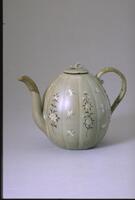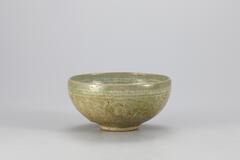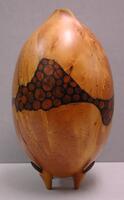17 UMMA Objects
17 UMMA Objects

Korean (Korean (culture or style))
Ewer in the shape of a melon with inlaid floral and butterfly designs
1100 – 1150
Gift of Mrs. Caroline I. Plumer for the James Marshall Plumer Collection
1973/2.33
![<p>The beginning of the 14th century saw a change in inlaid patterns from using both black and white clay to only using white clay, as demonstrated by this bowl. Concentric white circles extend around the upper and lower parts of the inner and outer surfaces, while the inner wall features a chrysanthemum design in three places. Sand is stuck to the foot and the outer base. The bowl is tinged with vivid yellow. Parts of the rim are slightly damaged, but the glaze is finely fused.<br />
[<em>Korean Collection, University of Michigan Museum of Art </em>(2014) p.107]</p>
<p>The beginning of the 14th century saw a change in inlaid patterns from using both black and white clay to only using white clay, as demonstrated by this bowl. Concentric white circles extend around the upper and lower parts of the inner and outer surfaces, while the inner wall features a chrysanthemum design in three places. Sand is stuck to the foot and the outer base. The bowl is tinged with vivid yellow. Parts of the rim are slightly damaged, but the glaze is finely fused.<br />
[<em>Korean Collection, University of Michigan Museum of Art </em>(2014) p.107]</p>](/media/W1siZiIsIjIwMjIvMDkvMjQvMjN4bWZrM29rYl9kZWZhdWx0LmpwZyJdLFsicCIsInRodW1iIiwiMjQweDIwMCJdXQ?sha=00c2f5b728ac5938)
Korean (Korean (culture or style))
Shallow bowl with inlaid chrysanthemum designs
14th century
Gift of Bruce and Inta Hasenkamp and Museum purchase made possible by Elder and Mrs. Sang-Yong Nam
2004/1.250
![<p>This octagonal dish is inlaid with a chrysanthemum design with white and black slip on each facet. Its outer base is entirely glazed and has three quartzite spur marks. The inner surface is undecorated but covered in crackles, revealing the gray body. The glaze was oxidized during ring, leaving many areas brown.<br />
[<em>Korean Collection, University of Michigan Museum of Art </em>(2014) p.117]<br />
</p>
<p>This octagonal dish is inlaid with a chrysanthemum design with white and black slip on each facet. Its outer base is entirely glazed and has three quartzite spur marks. The inner surface is undecorated but covered in crackles, revealing the gray body. The glaze was oxidized during ring, leaving many areas brown.<br />
[<em>Korean Collection, University of Michigan Museum of Art </em>(2014) p.117]<br />
</p>](/media/W1siZiIsIjIwMjIvMDkvMjQvNHVpbG92a2E1bl9kZWZhdWx0LmpwZyJdLFsicCIsInRodW1iIiwiMjQweDIwMCJdXQ?sha=811709a388c3f99f)
Korean (Korean (culture or style))
Octagonal faceted bowl with inlaid design of paired chrysanthemums on outer side
1250 – 1350
Gift of Bruce and Inta Hasenkamp and Museum purchase made possible by Elder and Mrs. Sang-Yong Nam
2004/1.234
![<p>The lid of this jar is carved with lotus petal design, crowned with the knob shaped as a lotus bud. Three refractory spurs are stuck to the inside of the lid. The shoulder of the jar is decorated with a descending willow design inlaid with white slip. The entire foot and outer base are glazed, but it is poorly fused and rough with impurities stuck to it. The lid retains a celadon color, but the jar itself is a light gray hue overall.<br />
[<em>Korean Collection, University of Michigan Museum of Art </em>(2014) p.134]</p>
<p>The lid of this jar is carved with lotus petal design, crowned with the knob shaped as a lotus bud. Three refractory spurs are stuck to the inside of the lid. The shoulder of the jar is decorated with a descending willow design inlaid with white slip. The entire foot and outer base are glazed, but it is poorly fused and rough with impurities stuck to it. The lid retains a celadon color, but the jar itself is a light gray hue overall.<br />
[<em>Korean Collection, University of Michigan Museum of Art </em>(2014) p.134]</p>](/media/W1siZiIsIjIwMjIvMDkvMjQvN2FsdDhlMjE5eV9kZWZhdWx0LmpwZyJdLFsicCIsInRodW1iIiwiMjQweDIwMCJdXQ?sha=e14cf9abceae9ee5)
Korean (Korean (culture or style))
Covered Cosmetic Jar
1167 – 1232
Gift of Bruce and Inta Hasenkamp and Museum purchase made possible by Elder and Mrs. Sang-Yong Nam
2004/1.243A&B

Korean (Korean (culture or style))
Wine cup with inlaid design of cranes flying among clouds
14th century
Gift of Bruce and Inta Hasenkamp and Museum purchase made possible by Elder and Mrs. Sang-Yong Nam
2004/1.247
![This mirror box is decorated with lacquer and mother-of-pearl inlaid designs. Thelid of the box opens upwards, and has brass hinges and a closure in the sahpe of a flower. The lower drawer has a handle in the shape of a bat.<br />
<br />
This box has a mirror attached to the inside of its lid and was used by women. The box is decorated with hexagon and bamboo motifs by employing <em>kkeuneumjil</em> and <em>jureumjil</em> techniques. Hinges made of nickel are decorated with chiseled peonies on a ringmat ground. The corner brackets, or side wrappers, are in “I” shape. The single drawer has a handle in the shape of a bat, realistic to the extent of depicting antenna. Lacquer was heavily repainted on the base of the drawer. The frame of the mirror inside was decorated with fret-patterned band on left and right sides, and saw-tooth design on upper and lower sides.
<p>[Korean Collection, University of Michigan Museum of Art (2017) p. 266]</p>
This mirror box is decorated with lacquer and mother-of-pearl inlaid designs. Thelid of the box opens upwards, and has brass hinges and a closure in the sahpe of a flower. The lower drawer has a handle in the shape of a bat.<br />
<br />
This box has a mirror attached to the inside of its lid and was used by women. The box is decorated with hexagon and bamboo motifs by employing <em>kkeuneumjil</em> and <em>jureumjil</em> techniques. Hinges made of nickel are decorated with chiseled peonies on a ringmat ground. The corner brackets, or side wrappers, are in “I” shape. The single drawer has a handle in the shape of a bat, realistic to the extent of depicting antenna. Lacquer was heavily repainted on the base of the drawer. The frame of the mirror inside was decorated with fret-patterned band on left and right sides, and saw-tooth design on upper and lower sides.
<p>[Korean Collection, University of Michigan Museum of Art (2017) p. 266]</p>](/media/W1siZiIsIjIwMjIvMDkvMjQvMXJ3cjZhb282Z19kZWZhdWx0LmpwZyJdLFsicCIsInRodW1iIiwiMjQweDIwMCJdXQ?sha=808892293221e0e4)
Korean (Korean (culture or style))
Mirror Box
19th century
Gift of Ellen and Richard Laing
2006/2.61
![It has a wide mouth and a shape which flared out to a generously-sized shoulder, then tapers to a slim lower body. It is a storage jar inlaid chrysanthemum, cloud and crane design.<br />
<br />
This is an ornate short-necked jar embellished with inlaid designs of clouds and cranes on its entire body. It is built by coiling due to its large size. Its shoulder and lower part of the body are inlaid with lotus petals, and the body is inlaid with cranes and chrysanthemums. Lumps of glaze are found on some parts of the body and pinpoles are found around the foot. Crazing was formed on the entire glazed surface. Shards of similar vessels had been excavated from Yucheon-ri, Buan- gun, Jeollabuk-do.<br />
[<em>Korean Collection, University of Michigan Museum of Art</em> (2014) p. 135]<br />
It has a wide mouth and a shape which flared out to a generously-sized shoulder, then tapers to a slim lower body. It is a storage jar inlaid chrysanthemum, cloud and crane design.<br />
<br />
This is an ornate short-necked jar embellished with inlaid designs of clouds and cranes on its entire body. It is built by coiling due to its large size. Its shoulder and lower part of the body are inlaid with lotus petals, and the body is inlaid with cranes and chrysanthemums. Lumps of glaze are found on some parts of the body and pinpoles are found around the foot. Crazing was formed on the entire glazed surface. Shards of similar vessels had been excavated from Yucheon-ri, Buan- gun, Jeollabuk-do.<br />
[<em>Korean Collection, University of Michigan Museum of Art</em> (2014) p. 135]<br />
](/media/W1siZiIsIjIwMjIvMDUvMjUvNHh2a2V5NzN6Nl9kZWZhdWx0LmpwZyJdLFsicCIsInRodW1iIiwiMjQweDIwMCJdXQ?sha=837137e88319b4be)
Korean (Korean (culture or style))
Storage jar with inlaid floral designs
1250 – 1350
Gift of Mrs. Henry Jewett Greene for The Mr. and Mrs. Henry Jewett Greene Memorial Collection
1972/2.33
![Inlaying silver into ironware was a popular method of decorating metalwork that required high levels of skill. Numerous items were produced with inlay decorations. The entire lid and body of this hexagonal case are decorated with inlaid silver. The lid features a hexagonal design in its center surrounded by a continuous four-leaf flower design. The six sides of the body are decorated by three pairs of turtle designs, crane designs and deer designs, arranged alternately. The lid and body are bordered with a fret-patterned band. This case with a flat base is excellently preserved. This type of iron-lidded case with inlaid silver design was produced in large quantities from the nineteenth century to the early twentieth century, continuing through the Japanese annexation of the Korean Peninsula. Such cases are mostly octagonal; this is a rare hexagonal example.
<p>[Korean Collection, University of Michigan Museum of Art (2017), 244]</p>
Inlaying silver into ironware was a popular method of decorating metalwork that required high levels of skill. Numerous items were produced with inlay decorations. The entire lid and body of this hexagonal case are decorated with inlaid silver. The lid features a hexagonal design in its center surrounded by a continuous four-leaf flower design. The six sides of the body are decorated by three pairs of turtle designs, crane designs and deer designs, arranged alternately. The lid and body are bordered with a fret-patterned band. This case with a flat base is excellently preserved. This type of iron-lidded case with inlaid silver design was produced in large quantities from the nineteenth century to the early twentieth century, continuing through the Japanese annexation of the Korean Peninsula. Such cases are mostly octagonal; this is a rare hexagonal example.
<p>[Korean Collection, University of Michigan Museum of Art (2017), 244]</p>](/media/W1siZiIsIjIwMjIvMDkvMjQvOThqa2s3NjF5M19kZWZhdWx0LmpwZyJdLFsicCIsInRodW1iIiwiMjQweDIwMCJdXQ?sha=8a82c3ce8eccee83)
Korean (Korean (culture or style))
Hexagonal Tobacco Box with Lid
1850 – 1950
Gift of Bruce and Inta Hasenkamp and Museum purchase made possible by Elder and Mrs. Sang-Yong Nam
2004/1.280A&B
![<p>This dish with a lobed rim was shaped with a mold. Inlaid on each lobed wall and at the center of its inner base with white slip are chrysanthemum spray design and a chrysanthemum floret, respectively. On the flat outer base remain three quartzite spur marks. The entire dish was glazed including the outer base; the state of sintering is good, while the glaze is pure and green. Crackles are spread throughout the inner and outer surfaces.<br />
[Korean Collection, University of Michigan Museum of Art (2014) p.116]</p>
<p>This dish with a lobed rim was shaped with a mold. Inlaid on each lobed wall and at the center of its inner base with white slip are chrysanthemum spray design and a chrysanthemum floret, respectively. On the flat outer base remain three quartzite spur marks. The entire dish was glazed including the outer base; the state of sintering is good, while the glaze is pure and green. Crackles are spread throughout the inner and outer surfaces.<br />
[Korean Collection, University of Michigan Museum of Art (2014) p.116]</p>](/media/W1siZiIsIjIwMjIvMDkvMjQvNGE2MWgzanBral9kZWZhdWx0LmpwZyJdLFsicCIsInRodW1iIiwiMjQweDIwMCJdXQ?sha=59566b92c81b187c)
Korean (Korean (culture or style))
Ten-lobed lotus saucer with inlaid floral patterns
13th century
Gift of Bruce and Inta Hasenkamp and Museum purchase made possible by Elder and Mrs. Sang-Yong Nam
2004/1.232
![<p>This oil bottle is decorated with inlaid white lines on the shoulder and four inlaid chrysanthemums on the body. It has the refractory spurs stuck on the foot and outer base, and the glaze is partially crawled around the foot. The foot is low and there are three quartzite spur marks. The glaze and the form of the bottle are good overall, despite partial damage.<br />
[<em>Korean Collection, University of Michigan Museum of Art </em>(2014) p.130]</p>
<p>This oil bottle is decorated with inlaid white lines on the shoulder and four inlaid chrysanthemums on the body. It has the refractory spurs stuck on the foot and outer base, and the glaze is partially crawled around the foot. The foot is low and there are three quartzite spur marks. The glaze and the form of the bottle are good overall, despite partial damage.<br />
[<em>Korean Collection, University of Michigan Museum of Art </em>(2014) p.130]</p>](/media/W1siZiIsIjIwMjIvMDkvMjQvNDlrcTJpZWZ1cF9kZWZhdWx0LmpwZyJdLFsicCIsInRodW1iIiwiMjQweDIwMCJdXQ?sha=84cc0897ee7ac71a)
Korean (Korean (culture or style))
Small Oil Bottle with inlaid chrysanthemum designs
1167 – 1199
Gift of Bruce and Inta Hasenkamp and Museum purchase made possible by Elder and Mrs. Sang-Yong Nam
2004/1.238
![<p>This bowl was produced between the late 12th and 13th century, when ornate decoration was accorded greater importance than the beauty of color. A small circle was incised at the inner bottom, surrounded by two concentric circles inlaid with white slip. On the inner wall are decorated four small medallions inside which are rendered chrysanthemum sprays. On both the upper part of the inner and outer walls are decorated a band of scrolls and a pair of horizontal lines, respectively. The low foot displays refractory spur marks. Glaze drips and cracks are visible in parts of the bowl’s surface.<br />
[<em>Korean Collection, University of Michigan Museum of Art</em> (2014) p.104]</p>
<p>This bowl was produced between the late 12th and 13th century, when ornate decoration was accorded greater importance than the beauty of color. A small circle was incised at the inner bottom, surrounded by two concentric circles inlaid with white slip. On the inner wall are decorated four small medallions inside which are rendered chrysanthemum sprays. On both the upper part of the inner and outer walls are decorated a band of scrolls and a pair of horizontal lines, respectively. The low foot displays refractory spur marks. Glaze drips and cracks are visible in parts of the bowl’s surface.<br />
[<em>Korean Collection, University of Michigan Museum of Art</em> (2014) p.104]</p>](/media/W1siZiIsIjIwMjIvMDkvMjQvNjk3YnprbTBpZ19kZWZhdWx0LmpwZyJdLFsicCIsInRodW1iIiwiMjQweDIwMCJdXQ?sha=d4cfc0a923163d52)
Korean (Korean (culture or style))
Shallow bowl with inlaid chrysanthemum roundels, black and white slip
1150 – 1199
Gift of Bruce and Inta Hasenkamp and Museum purchase made possible by Elder and Mrs. Sang-Yong Nam
2004/1.241
Loading…

